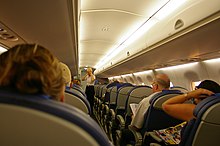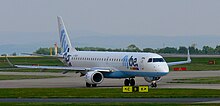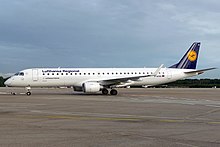Embraer E-Jet family: Difference between revisions
Revert uncited total built changes |
Quentela1234 (talk | contribs) |
||
| Line 111: | Line 111: | ||
|- |
|- |
||
! E-190 |
! E-190 |
||
|[[File: |
|[[File:Austral Líneas Aéreas Embraer 190AR LV-CHQ.jpeg|100px]] |
||
|563 |
|563 |
||
|204 |
|204 |
||
Revision as of 22:27, 22 September 2013
| E-Jet family E-170/E-175/E-190/E-195 | |
|---|---|

| |
| An Embraer 170 in new livery of launch customer LOT Polish Airlines landing at Amsterdam Airport (2012). | |
| Role | Airliner |
| National origin | Brazil |
| Manufacturer | Embraer |
| First flight | February 19, 2002 |
| Introduction | March 17, 2004 with LOT Polish Airlines |
| Status | In service |
| Primary users | Republic Airways Air Canada JetBlue Airways Compass Airlines Austral Líneas Aéreas |
| Produced | 2001–present |
| Number built | 947 (as of June 2013)[1] |
| Variants | Embraer Lineage 1000 |
| Developed into | Embraer E-Jet E2 family |
The Embraer E-Jet family is a series of narrow-body medium-range twin-engine jet airliners produced by Brazilian aerospace conglomerate Embraer. Announced at the Paris Air Show in 1999, and entering production in 2002, the aircraft series has been a commercial success.[2] The aircraft is used by both mainline and regional airlines around the world. As of 31 December 2012[update], there is a backlog of 185 firm orders for the E-Jets, 580 options and 908 units delivered.[3]
Design and development
The Embraer E-Jets line is composed of two main commercial families and a business jet variant. The smaller E-170 and E-175 make up the base model aircraft. The E-190 and E-195 are stretched versions, with different engines and larger wing, horizontal stabilizer and landing gear structures. The 170 and 175 share 95% commonality, as do the 190 and 195. The two families share near 89% commonality, with identical fuselage cross-sections and avionics, featuring the Honeywell Primus Epic EFIS suite.[4]
All E-Jets use four-abreast seating (2+2) and have a "double-bubble" design, which Embraer developed for its commercial passenger jets, that provides stand-up headroom. Although commonly referred to with simply an "E" prefix, the jets are technically still Embraer Regional Jets ("ERJ"s), which still refers to the smaller Embraer ERJ range.[5] Embraer dropped the ERJ prefix in its advertising early in production. The E-190/195 series of aircraft have similar capacities to the initial versions of the McDonnell Douglas DC-9 and Boeing 737, which have always been considered mainline airliners.

The launch customers for the aircraft were the French airline Régional Compagnie Aérienne Européenne with ten orders and five options for the E-170; and the Swiss airline Crossair with an order for 30 E-170s and 30 E-190s.[6] The largest single order for any type of E-Jets has come from JetBlue with 100 orders for the E-190, and options for 100 more.[4] JetBlue set the record for the longest flight of the E-190 family on November 6, 2008, when one of its aircraft made a non-stop flight from Anchorage, Alaska (Ted Stevens Anchorage International Airport) to Buffalo, New York (Buffalo Niagara International Airport), a total of 2,694 nmi (4,989 km). This was an empty aircraft on a non-revenue flight. The aircraft eventually returned to JFK after a two-month-long charter service with Vice Presidential candidate Sarah Palin.[7]
In November 2011, Embraer announced it would re-engine the E-Jet family and deliver the first example before 2018.[8] On January 8, 2013, Embraer announced its selection of Pratt & Whitney to provide exclusive power for the re-engined E-Jet family.[9][10]
In February 2012, Embraer announced they are studying the development of a new variant with 130 seating capacity.[11] The study is expected to be completed by the end of 2012.[12]
Variants



E-170 and 175
The E-170/E-175 models in the 80-seat range are the smaller in the E-Jet family. They are powered with General Electric CF34-8E engines of 14,200 pounds (62.28 kN) thrust each. The E-170 and E-175 directly compete with the Bombardier CRJ-700 and Bombardier CRJ-900, respectively, and loosely compete with the turboprop Bombardier Q400. They also seek to replace the market segment occupied by earlier competing designs such as the BAe 146 and Fokker 70.
The Embraer 170 was the first version produced. The prototype 170-001, registration PP-XJE, was rolled out on 29 October 2001, with first flight 119 days later on February 19. The aircraft was displayed to the public in May 2002 at the Regional Airline Association convention. After a positive response from the airline community, Embraer launched the E-175. First flight of the stretched E-175 was on June 2003.[13] Certification for the 170 took nearly 2 years after the public debut; delivery of the first E170 aircraft to the launch customer LOT Polish Airlines was in March 2004.[14] The launch U.S. customer For the EMB 170 was US Airways, after FAA certification, the aircraft entered into revenue service on April 4, 2004 operated by the MidAtlantic division of US Airways, Inc. The first E-175 was delivered to Air Canada and entered service in July 2005.[13] The 170-001 prototype performed its last flight on April 11, 2012. Its destiny was disassembly in the US for spare parts.
E-190 and 195
The E-190/195 models are a larger stretch of the E-170/175 models fitted with a new, larger wing, larger horizontal stabilizer and a new engine, the GE CF34-10E,[4] rated at 18,500 lb (82.30 kN). These aircraft compete with the Bombardier CRJ-1000. In addition, being in the 110-seat range, they compete with smaller mainline jets including the Boeing 717-200 and 737-500/-600, the Airbus A318, and some of the upcoming Bombardier CSeries.
The first flight of the E-190 was on March 12, 2004 (PP-XMA),[15] with the first flight of the E-195 (PP-XMJ)[15] on December 7 of the same year. The launch customer of the E-190 was New York-based low-cost carrier JetBlue with 100 orders and 100 options. British low-cost carrier Flybe launched the E-195 with 14 orders and 12 options.[16]
As the 190/195 models are of mainline aircraft size, many airlines will operate them as such, fitting them with a business class section and operating them themselves, instead of having them flown by a regional airline partner.[citation needed] For example, Air Canada operates 45 E-190 aircraft fitted with 9 business-class and 88 economy-class seats (currently modifying from 84 seats) as part of its primary fleet.
Embraer Lineage 1000
On 2 May 2006, Embraer announced plans for the business jet variant of the E-190. This would have the same structure as the E-190, but with an extended range of up to 4,200 nm, and luxury seating for up to 19. It was certified by the USA Federal Aviation Administration on 7 January 2009. The first two production aircraft were delivered in December 2008.
Undeveloped variants
E-195X
Embraer considered producing an aircraft which was known as the E-195X, a stretched version of the E-195. It would have seated approximately 130 passengers. The E-195X was apparently a response to American Airlines' request for a replacement for their MD-80s.[17] Embraer abandoned plans for the 195X in May 2010, following concerns that its range would be too short.[18]
E-Jets Second Generation
In 2011, Embraer announced that it would focus its attention on developing revamped versions of the E-Jet family, rather than an all-new aircraft, for the time being. The new variants would be better-positioned to compete with the Bombardier CSeries, and would be powered by new engines with larger diameter fans that would offer improvements in specific fuel consumption, as well as slightly taller landing gear and possibly a new aluminum or carbon fiber-based wing. Air Lease Corp has tentatively named the revamped E-Jet the E-198, and has advised Embraer to stretch the E-190 by one row (seating 118 in a one-class configuration) and the E-195 by two to three rows (seating 130 to 134). Later on, Embraer named it "second generation".[19] GE, Pratt & Whitney, and Rolls-Royce were all possible engine suppliers.[20] Pratt & Whitney's geared turbofan engine was selected in January 2013 as the engine for the new E-Jets versions.[10] Honeywell Primus Epic 2 was selected as the avionics package [19]
Operators



- Embraer 170 (or EMB 170-100)—As of July 2011[update] 180 Embraer 170 aircraft (all variants) are in airline service, with 8 orders. Major operators include: Republic Airlines (48), Shuttle America (28), Saudia (15), EgyptAir Express (12), LOT Polish Airlines (10), and Alitalia CityLiner (6).[21] About 15 airlines operate the type in smaller numbers.[22]
- Embraer 175 (or EMB 170-200)—As of July 2011[update], 136 Embraer 175 aircraft are in airline service, with 53 further orders. Major operators include Air Canada with 15 aircraft and Kenya Airways with 8 aircraft and LOT Polish Airlines with 12 aircraft.[21] Major firm orders include 54 aircraft for Republic Airlines, which controls Frontier Airlines and Midwest Airlines, and 36 aircraft for Compass Airlines (formerly a subsidiary of Delta Air Lines).[22] Flybe, the British airline, ordered 35 Embraer 175 with options for an extra 60 and "purchase rights" for 40 more at the 2010 Farnborough airshow.[23]
- Embraer 190 (or EMB 190-100)—As of July 2011[update], 349 Embraer 190 aircraft (all variants) are in airline service, with 170 orders. Operators include Air Astana with two aircraft in operation and 6 more in order, Air Canada with 45 aircraft (with options for 60 more), JetBlue Airways with 47 aircraft (104 firm orders), Copa Airlines with 26, KLM Cityhopper (17), Aeroméxico Connect (19), Virgin Australia (18), Azul Brazilian Airlines (10), TRIP Linhas Aéreas (10) and Nas Air (Saudi Arabia) (4). Other orders include 32 aircraft for US Airways and 20 for Austral Líneas Aéreas (Argentina).[22]
- Embraer 195 (or EMB 190-200)—As of July 2011[update], 75 Embraer 195 aircraft (all variants) are in service and 30 firm orders. Major operators are Azul Brazilian Airlines (29), Flybe (14), Lufthansa CityLine (15), Air Europa (11) and Air Dolomiti (5). Azul Brazilian Airlines have ordered more 41 aircraft of this type.[22]
Orders and deliveries
List of Embraer's E-Jet family deliveries and orders:
| Model | Photo | Firm Orders | Options | Deliveries | Firm Order Backlog |
|---|---|---|---|---|---|
| E-170 | 
|
193 | 27 | 185 | 8 |
| E-175 | 
|
315 | 498 | 166 | 149 |
| E-190 | 
|
563 | 204 | 473 | 90 |
| E-195 | 
|
142 | 20 | 123 | 19 |
| Total | 1213 | 749 | 947 | 266 |
Source: Embraer Delivers 22 Commercial and 29 Executive Jets in 2Q13.[1]
Accidents and incidents
- On 24 August 2010, Henan Airlines Flight 8387, an Embraer E-190 that departed from Harbin, People's Republic of China, crash landed about 1 km short of the runway at Yichun Lindu Airport, resulting in 42 deaths.[24]
- 16 September 2011: TAME Flight 148 from Loja, Embraer E-190 with registration HC-CEZ, with 97 passengers and 6 crew on board, slipped off the runway at approximately 19:15 ECT (00:15 UTC) at Mariscal Sucre International Airport.[25]
- 27 February 2012: Shuttle America Flight 5124 from Atlanta, Embraer E-170, with 67 passengers and 4 crew on board, made an emergency landing without nose gear extended at Newark Airport. [26] [27]
- 29 June 2012: Tianjin Airlines Flight 7554 from Hotan Airport to Ürümqi Diwopu International Airport, an Embraer E-190, passengers and crew members thwarted an attempt to hijack a plane in the western Chinese province of Xinjiang.[28]
Specifications
| Variant | E-170 (ERJ170-100) |
E-175 (ERJ170-200) |
E-190 (ERJ190-100) |
E-195 (ERJ190-200) |
|---|---|---|---|---|
| Flight Deck Crew | 2 pilots | |||
| Passenger capacity | 80 (1-class, 29 in/30 in pitch) 78 (1-class, 30 in/31 in) 70 (1-class, 32 in) 70 (2-class, 36 in/32 in) [29] |
88 (1-class, 30 in pitch) 86 (1-class, 31 in) 78 (1-class, 32 in) 78 (2-class, standard) [30] |
114 (1-class, 29 in/30 in pitch) 106 (1-class, 31 in) 98 (1-class, 32 in) 94 (2-class, standard) [31] |
122 (1-class, 30 in/31 in pitch) 118 (1-class, 31 in) 108 (1-class, 32 in) 106 (2-class, standard) [32] |
| Length | 29.90 m (98 ft 1 in) |
31.68 m (103 ft 11 in) | 36.24 m (118 ft 11 in) | 38.65 m (126 ft 10 in) |
| Wingspan | 26.00 m (85 ft 4 in) | 28.72 m (94 ft 3 in) | ||
| Height | 9.67 m (32 ft 4 in) |
10.28 m (34 ft 7 in) | ||
| Empty Weight | 21,140 kg (46,610 lb) | 21,810 kg (48,080 lb) | 28,080 kg (61,910 lb) | 28,970 kg (63,870 lb) |
| Maximum takeoff weight | 35,990 kg (79,340 lb) (STD) 37,200 kg (82,000 lb) (LR) 38,600 kg (85,100 lb) (AR) |
37,500 kg (82,700 lb) (STD) 38,790 kg (85,520 lb) (LR) 40,370 kg (89,000 lb) (AR) |
47,790 kg (105,360 lb) (STD) 50,300 kg (110,900 lb) (LR) 51,800 kg (114,200 lb) (AR) |
48,790 kg (107,560 lb) (STD) 50,790 kg (111,970 lb) (LR) 52,290 kg (115,280 lb) (AR) |
| Max payload weight | 9,100 kg (20,100 lb) (STD&LR) 9,840 kg (21,690 lb) (AR) |
10,080 kg (22,220 lb) (STD&LR) 10,360 kg (22,840 lb) (AR) |
13,080 kg (28,840 lb) | 13,650 kg (30,090 lb) |
| Takeoff Run at MTOW | 1,644 m (5,394 ft) | 2,244 m (7,362 ft) | 2,056 m (6,745 ft) | 2,179 m (7,149 ft) |
| Powerplants | 2× GE CF34-8E turbofans 61.4 kN (13,800 lbf) thrust each 63.2 kN (14,200 lbf) APR thrust each |
2× GE CF34-10E turbofans 82.3 kN (18,500 lbf) thrust each 89 kN (20,000 lbf) APR thrust each | ||
| Maximum speed | 890 km/h (481 kn, Mach 0.82) | |||
| Range | STD: 3,334 km (1,800 nmi) LR: 3,889 km (2,100 nmi) AR: 3,892 km (2,102 nmi) |
STD: 3,334 km (1,800 nmi) LR: 3,889 km (2,100 nmi) AR: 3,706 km (2,001 nmi) |
STD: 3,334 km (1,800 nmi) LR: 4,260 km (2,300 nmi) AR: 4,448 km (2,402 nmi) |
STD: 2,593 km (1,400 nmi) LR: 3,334 km (1,800 nmi) AR: 4,077 km (2,201 nmi) |
| Maximum fuel load | 9,335 kg (20,580 lb) | 12,971 kg (28,596 lb) | ||
| Service ceiling | 41,000 ft (12,500 m) | |||
| Thrust-to-weight | 0.42:1 | 0.39:1 | 0.41:1 | 0.39:1 |
| Fuselage and cabin cross-section | ||||
| Outer width | 3.01 m (9 ft 11 in) | |||
| Cabin width | 2.74 m (9 ft 0 in) | |||
| Outer height | 3.35 m (11 ft 0 in) | |||
| Cabin height | 2.00 m (6 ft 7 in) | |||
Sources: Embraer E-jet[33]
See also
Related development
Aircraft of comparable role, configuration, and era
- Airbus A318
- Antonov An-148
- Boeing 717
- Boeing 737-600
- Bombardier CRJ700 series
- Bombardier CSeries
- COMAC ARJ21
- Fokker 70/100
- Mitsubishi MRJ 70/MRJ 90
- Sukhoi Superjet 100
- Tupolev Tu-334
Related lists
References
- ^ a b "Embraer Delivers 22 Commercial and 29 Executive Jets in 2Q13". Embraer
- ^ "Embraer: E-Jet sales success spurred deployment hiccups-22/05/2007-Washington DC-Flight International". Retrieved 2010-10-27.
- ^ "Embraer In Numbers". Embraer.com. Retrieved 2012-10-16.
- ^ a b c "JetBlue orders 100 Embraer 190 Aircraft" (Press release). JetBlue. 2003-06-10. Retrieved 2012-06-24.
- ^ "Embraer 170/175/190/195 Aircraft Data". Airliners.net. Retrieved 2006-07-17.
- ^ "Embraer ERJ-170". Flug Revue. Archived from the original on 3 February 2010.
{{cite web}}: External link in|deadurl=|deadurl=ignored (|url-status=suggested) (help) - ^ Mutzabaugh, Ben (2008-11-07). "JetBlue sets world record with McCain-Palin campaign plane". Usatoday.com. Retrieved 2012-10-16.
- ^ "Embraer Commits to re-engined E-Jets". Retrieved November 12, 2011.
- ^ "Pratt & Whitney wins contract for Embraer's new E-Jets". Retrieved January 8, 2013.
- ^ a b Polek, Gregory (January 8, 2013). "Embraer To Re-engine E-Jets with Geared Turbofan". AINonline. Retrieved January 8, 2013.
- ^ "Embraer estuda produzir avião maior, com 130 lugares" (in Portuguese). Exame, 3 February 2012. Retrieved: 5 February 2012.
- ^ "Embraer To Complete E-Jet Study By Year End". 14 February 2012. Retrieved: 14 February 2012.
- ^ a b "Embraer 170". Aerospace-technology.com. 2011-06-15. Retrieved 2012-10-16.
- ^ "600th production E-Jet delivered to LOT - News". Shephard. 2009-09-15. Retrieved 2012-10-16.
- ^ a b "RAB - Registro Aeronautico Brasileiro". ANAC. Retrieved 2011-01-31.
- ^ "About our fleet". flybe.com. 2007. Archived from the original on 2008-02-24. Retrieved 2008-05-23.
- ^ Kirby, Mark (January 2010). "Proposed stretch dubbed E-195X by Embraer". Retrieved 2010-01-26.
- ^ "Embraer kills 195X over range concerns". Flight International. 2010. Retrieved 2010-05-14.
- ^ a b "Embraer Selects Pratt & Whitney's PurePower Engines for Second Generation of E-Jets". EMBRAER. January 8, 2013. Retrieved March 5, 2013. Cite error: The named reference "EMBRAER" was defined multiple times with different content (see the help page).
- ^ Ostrower, Jon (March 20, 2012). "E-Jet revamp promises three-way engine 'dogfight'". Flightglobal. Retrieved 2012-03-20.
- ^ a b LOT Polish Airlines (undated). "Fleet". Retrieved 2009-07-23.
{{cite web}}: Check date values in:|date=(help) [dead link] - ^ a b c d Flight International, 3–9 October 2006
- ^ "FARNBOROUGH: Flybe orders up to 140 Embraer jets". Retrieved 2010-07-21.
- ^ Wivell, David (2010-08-25). "Safety concerns raised about China crash runway". The Seattle Times. Associated Press. Retrieved 2010-12-18.
- ^ Perry, Dominic (17 September 2011). "PICTURES: No casualties in TAME overrun". FlightGlobal. Air Transport Intelligence. Retrieved 19 September 2011.
- ^ Messing, Philip; Greene, Leonard (2012-02-27). "Emergency landing at Newark International Airport". New York Post.
- ^ "Accident: Shuttle America E170 at Newark on Feb 27th 2012, nose gear did not extend". 28 February 2012. Retrieved 15 September 2013.
- ^ Jiang, Steven (2012-06-30). "Passengers and crew foil hijack attempt in China". CNN.
- ^ "Embraer 170 Specifications" (PDF). Embraercommercialjets.com. Retrieved 2012-10-16.
- ^ "Embraer 175 Specifications" (PDF). Embraercommercialjets.com. Retrieved 2012-10-16.
- ^ "Embraer 190 Specifications" (PDF). Embraercommercialjets.com. Retrieved 2012-10-16.
- ^ "Embraer 195 Specifications" (PDF). Embraercommercialjets.com. Retrieved 2012-10-16.
- ^ Embraer E-jet specifications, accessed Dec 26, 2009
